

Udl guidelines 2018.
Teaching Tolerance. Mobile is under maintenance. Udl strategies. Peer Interaction Pedagogical Models. This week we will be learning about peer interaction pedagogical models.

The most utilized of the peer interaction models are cooperative and collaborative learning models. There are two major differences between cooperative and collaborative learning. The first major difference is that collaboration is a philosophical view on education through student centered interactive activities centered on working together towards an end. The process of working together is most valued in collaboration. Five Basic Elements of Cooperative Learning.
There are five fundamental elements involved in cooperative learning.
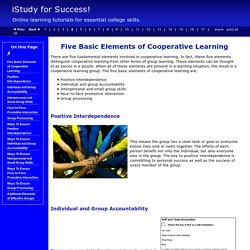
In fact, these five elements distinguish cooperative learning from other forms of group learning. These elements can be thought of as pieces in a puzzle. What Is Differentiated Instruction? Teaching Techniques, LD, ADHD. In any general education classroom, there are students with various learning styles.

Some learn best by reading and writing. Individualized vs. Differentiated Instruction. In a typical classroom, you’ll find students who are reading above their grade level and others who are behind.
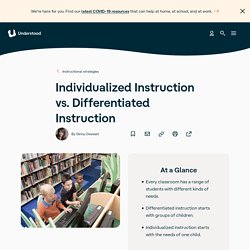
You might find that some learn best by working with other kids, while others prefer working alone. And some students need special help along the way to fill in areas where they struggle. The best teachers reach all their students by giving the whole class a great experience. But they change up the material a bit for each student so everyone learns at their own pace. is a teaching method for groups of students. Differentiated Instruction. What Is Differentiated Instruction? Teaching Techniques, LD, ADHD.
The Hot Seat. Are you looking for interactive learning structures that will help your students gain a deeper understanding of content while also developing and practicing higher level thinking skills?
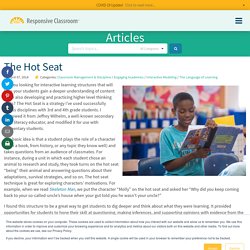
The Hot Seat is a strategy I’ve used successfully across disciplines with 3rd and 4th grade students. I borrowed it from Jeffrey Wilhelm, a well-known secondary level literacy educator, and modified it for use with elementary students. The basic idea is that a student plays the role of a character (from a book, from history, or any topic they know well) and takes questions from an audience of classmates. For instance, during a unit in which each student chose an animal to research and study, they took turns on the hot seat “being” their animal and answering questions about their adaptations, survival strategies, and so on.
Costas questioning 14. Teaching Strategies: Stimulate Through Effective Questioning. If you’re looking to improve the effectiveness of your teaching strategies, it’s best to start by improving your questions.
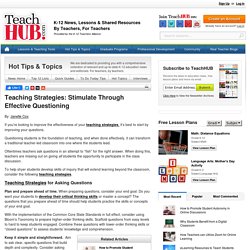
Questioning students is the foundation of teaching, and when done effectively, it can transform a traditional teacher-led classroom into one where the students lead. Oftentimes teachers ask questions in an attempt to “fish” for the right answer. When doing this, teachers are missing out on giving all students the opportunity to participate in the class discussion. To help shyer students develop skills of inquiry that will extend learning beyond the classroom, consider the following teaching strategies. Teaching Open-Ended Socratic Questions: Encourage Students to Think Critically. Socrates: Master Questioner In ancient Greece, Socrates developed a means of teaching by asking questions as if he had no clue of the subject.
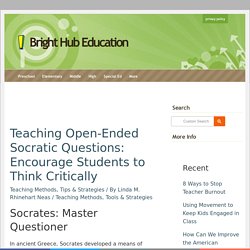
This technique. Open-Ended Questions. Language is one of the most powerful tools available to teachers.
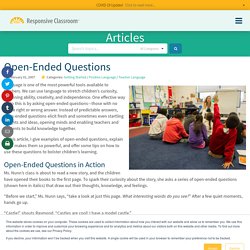
We can use language to stretch children’s curiosity, reasoning ability, creativity, and independence. Fishbowl. SocSem. (1) Rhonda Clyatt - QAR: Teacher Review - LEaRN DVD3 ES9. 20 Differentiated Instruction Strategies & Examples. As students with diverse learning styles fill the classroom, many teachers don’t always have the time to plan lessons that use differentiated instruction (DI) to suit their distinct aptitudes. This can involve adjusting: Content — The media and methods teachers use to impart and instruct skills, ideas and informationProcesses — The exercises and practices students perform to better understand contentProducts — The materials, such as tests and projects, students complete to demonstrate understanding To help create lessons that engage and resonate with a diverse classroom, below are 20 differentiated instruction strategies and examples.
Available in a condensed and printable list for your desk, you can use 16 in most classes and the last four for math lessons. Try the ones that best apply to you, depending on factors such as student age. 1. Provide different types of content by setting up learning stations — divided sections of your classroom through which groups of students rotate. 2. 3. Sdaie. WHERETO. Putting It All Together The WHERETO Framework. Exploratory Pedagogical Models. A note before we start: Everyone is learning the "Webquest" model, simply by interacting with this Webquest. As such you will not be allowed to choose a "Webquest" for your teaching presentation/exploration. After brief exploration of the various exploratory models, choose the model you intend to use to teach the mini lesson.
Click on the model below and navigate through all the links connected to that model. Keep in mind that you will need to create a 5-10 minute mini-lesson using your model, in order to teach your model, so explore all resources thoroughly. Inquiry Based Methods: Inquiry methods are often considered an overarching group of methods that includes the models listed below (Webquests, Discovery, Project based, 5E, etc...). Discovery Learning Methods.